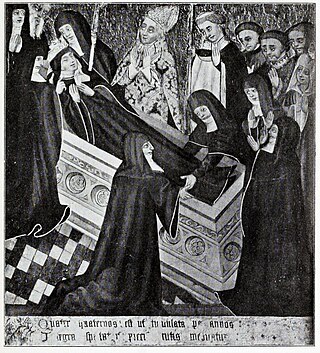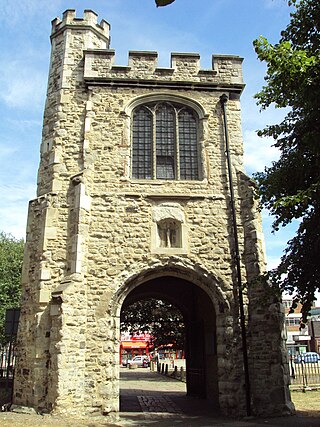
Eadburh was the daughter of King Edward the Elder of England and his third wife, Eadgifu of Kent. She lived most of her life as a nun known for her singing ability. Most of the information about her comes from hagiographies written several centuries after her life. She was canonised twelve years after her death and there are a small number of churches dedicated to her, most of which are located near Worcestershire, where she lived.

Minster, also known as Minster-in-Thanet, is a village and civil parish in the Thanet District of Kent, England. It is the site of Minster in Thanet Priory. The village is west of Ramsgate and to the north east of Canterbury; it lies just south west of Kent International Airport and just north of the River Stour. Minster is also the "ancient capital of Thanet". At the 2011 Census the hamlet of Ebbsfleet was included.
Ecgberht I was a King of Kent (664-673), succeeding his father Eorcenberht.

Hilda of Whitby was a Christian virgin and saint of the Roman Catholic Church]]. She was the founder and first abbess of the monastery at Whitby which was chosen as the venue for the Synod of Whitby in 664. An important figure in the Christianisation of Anglo-Saxon England, she was abbess in several convents and recognised for the wisdom that drew kings to her for advice.

Seaxburh, also Saint Sexburga of Ely was a Queen as well as an abbess, and is a saint of the Christian Church. She was married to King Eorcenberht of Kent.

Saint Mildburh was the Benedictine abbess of Wenlock Priory. Her feast day is 23 February.
Saints Æthelred and Æthelberht according to the Kentish royal legend were princes of the Kingdom of Kent who were murdered in around AD 669, and later commemorated as saints and martyrs. Their story forms an important element in the legend of Saint Mildrith, because the monastery of Minster in Thanet is said to have been founded in atonement for the crime.

Saint Mildrith, also Mildthryth, Mildryth and Mildred,, was a 7th and 8th-century Anglo-Saxon abbess of the Abbey at Minster-in-Thanet, Kent. She was declared a saint after her death, and later her remains were moved to Canterbury.
Saint Edburga of Minster-in-Thanet was a princess of Wessex, and abbess of Minster-in-Thanet. She is regarded as a saint.
Leofrun was the abbess of St Mildred's, Minster-in-Thanet, Kent, a Benedictine abbey for nuns.
St. Mary's Abbey, also known as the Nunnaminster, was a Benedictine nunnery in Winchester, Hampshire, England. It was founded between 899 and 902 by Alfred the Great's widow Ealhswith, who was described as the 'builder' of the Nunnaminster in the New Minster Liber Vitae. The first buildings were completed by their son, Edward the Elder. Among the house's early members was Edward's daughter Edburga.

Domne Eafe, also Domneva, Domne Éue, Æbbe, Ebba, was, according to the Kentish royal legend, a granddaughter of King Eadbald of Kent and the foundress of the double monastery of Minster in Thanet Priory at Minster-in-Thanet during the reign of her cousin King Ecgberht of Kent. A 1000-year-old confusion with her sister Eormenburg means she is often now known by that name. Married to Merewalh of Mercia, she had at least four children. When her two brothers, Æthelred and Æthelberht, were murdered she obtained the land in Thanet to build an abbey, from a repentant King Ecgberht. Her three daughters all went on to become abbesses and saints, the most famous of which, Mildrith, ended up with a shrine in St Augustine's Abbey, Canterbury.
Eormenred was a member of the royal family of the Kingdom of Kent, who is described as king in some texts. There is no contemporary evidence for Eormenred, but he is mentioned in later hagiographies, and his existence is considered possible by scholars.
Repton Abbey was an Anglo-Saxon Benedictine abbey in Derbyshire, England. Founded in the 7th century, the abbey was a double monastery, a community of both monks and nuns. The abbey is noted for its connections to various saints and Mercian royalty; two of the thirty-seven Mercian Kings were buried within the abbey's crypt. The abbey was abandoned in 873, when Repton was overrun by the invading Great Heathen Army.

December 12 - Eastern Orthodox liturgical calendar - December 14
The Kentish Royal Legend is a diverse group of Medieval texts which describe a wide circle of members of the royal family of Kent from the 7th to 8th centuries AD. Key elements include the descendants of Æthelberht of Kent over the next four generations; the establishment of various monasteries, most notably Minster-in-Thanet; and the lives of a number of Anglo-Saxon saints and the subsequent travels of their relics. Although it is described as a legend, and contains a number of implausible episodes, it is placed in a well attested historical context.
Sister Concordia Scott was a Scottish sculptor and Benedictine nun, of the Minster Abbey community, Minster-in-Thanet, Kent. Her commissioned works have included statues for Westminster Abbey, Canterbury Cathedral, Coventry Cathedral and the National Shrine of Wales as well as numerous sculptures currently in Europe and the United States of America.

Hildelith of Barking, also known as Hildilid or Hildelitha, was an 8th-century Christian saint, from Anglo-Saxon England but was of foreign origin.

St Augustine's Abbey or Ramsgate Abbey is a former Benedictine abbey in Ramsgate. It was built in 1860 by Augustus Pugin and is a Grade II listed building. It was the first Benedictine monastery to be built in England since the Reformation. In 2010, the monks moved to St Augustine's Abbey in Chilworth, Surrey. The site is now owned by the Vincentian Congregation from Kerala, India. The church of St Augustine, across the road from the abbey site, belongs to the Archdiocese of Southwark and is a shrine of St Augustine of Canterbury.












